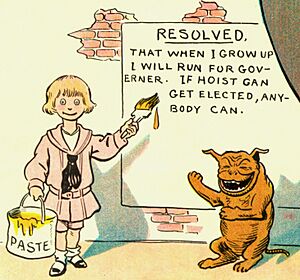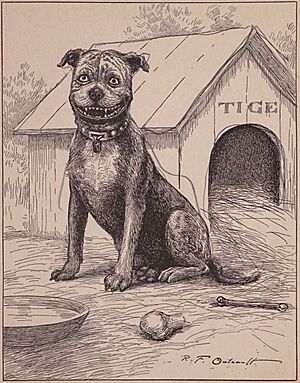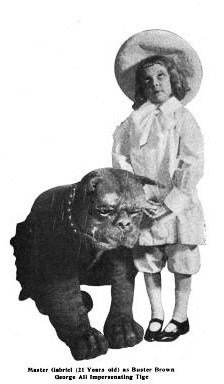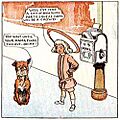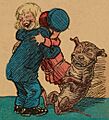Buster Brown facts for kids
Quick facts for kids Buster Brown |
|
|---|---|

Buster Brown
|
|
| Publication information | |
| Publisher | New York Herald |
| First appearance | May 4, 1902 |
| Created by | Richard F. Outcault |
| In-story information | |
| Team affiliations | Mary Jane, Tige |
Buster Brown is a famous comic-strip character. He was created in 1902 by Richard F. Outcault. Buster Brown, his girlfriend Mary Jane, and his dog Tige became very well known in America. This happened in the early 1900s.
In 1904, the Brown Shoe Company chose Buster Brown as their mascot. The character's name also became popular for a style of suit for young boys. This suit, called the Buster Brown suit, looked just like his outfit.
Contents
How Buster Brown Began
The character of Buster Brown was based on a real boy. His name was Granville Hamilton Fisher. He lived in Flushing, New York. Outcault copied Fisher's look, including his special pageboy haircut, for Buster Brown. The name "Buster" might have come from Buster Keaton. Keaton was a famous child actor in vaudeville at the time. Another boy, Roger Cushman Clark, was also said to be a model for the character.
Mary Jane, Buster's girlfriend, was also based on a real person. She was Outcault's own daughter, who had the same name. Outcault said she was the only character in the comic strip drawn from real life. However, "Mrs. Brown" did look a lot like Outcault's wife.
Comic Strip History
| Buster Brown | |
|---|---|

Richard F. Outcault's Buster Brown (1917)
|
|
| Author(s) | Richard F. Outcault |
| Current status/schedule | Concluded |
| Launch date | May 4, 1902 |
| End date | c. 1921 |
| Syndicate(s) | New York Herald (1902–1906) Hearst Corporation (1906–c. 1921) |
| Genre(s) | humor |
The Buster Brown comic strip first appeared in the New York Herald newspaper. This was on May 4, 1902. In 1906, Outcault started working for William Randolph Hearst. After some legal issues, Outcault continued his comic strip in Hearst's newspapers. The Herald also kept publishing Buster Brown with different artists. Outcault's version ran until 1923.
Buster Brown was so popular that he inspired other comic characters. These included Perry Winkle from the Winnie Winkle strip. He also inspired the Bobby Bumps animated film series. The comic was even translated into Portuguese. It was published in a Brazilian children's magazine called O Tico-Tico. In Brazil, Buster Brown was known as Chiquinho.
Main Characters
Buster Brown
Buster Brown is a young boy from the city. He has rich parents. He looks very neat and proper. But his actions are often quite mischievous! He loves to play practical jokes. He might swap clothes with a girl or break a window with his slingshot. He also enjoys playing pranks on his neighbors.
After his pranks, Buster usually gets caught and punished. This is often done by his mother. But it's not always clear if he truly feels sorry. Many comic strips end with Buster writing a "Resolved!" message. These messages are supposed to be moral lessons. But they often have little to do with what he actually did wrong. For example, in one strip, he spills soda on a woman's dress. His mother punishes him. Then Buster writes, "Resolved! That druggists are legalized robbers..."
Mary Jane
Mary Jane is Buster's girlfriend. She was based on the creator R. F. Outcault's real daughter. Her parents are not often mentioned in the comics. But sometimes, letters from her mother appear at the top of the comic strips. Mary Jane has curly black hair and brown eyes. She usually wears a blue, frilly dress. She also wears a large bow and Mary Jane shoes with black stockings.
Tige
Tige is Buster Brown's loyal dog. He is believed to be the first talking pet in comics! Unlike some cartoon animals, adults in the comic can actually hear Tige speak. This often shocks them! Tige was a very popular character. He even had his own book in 1905. It was called "Tige" His Story.
Buster Brown as a Shoe Mascot
Richard Outcault went to the 1904 St. Louis World's Fair. There, he sold licenses to many companies. These companies could use the Buster Brown characters to advertise their products. John Bush, a sales executive for the Brown Shoe Company, saw this opportunity. He convinced his company to buy the rights to the Buster Brown name. The shoe brand was then launched at the 1904 World's Fair.
The Brown Shoe Company hired actors who were small in stature to play Buster. These actors traveled around the United States. They performed in department stores, theaters, and shoe stores. Each actor was joined by a dog playing Tige. These tours happened from 1904 until 1930. Richard Barker was one actor who played Buster Brown in many of these advertising campaigns. His story is told in a book called Buster Brown and the Cowboy.
In the 1940s and 1950s, the Brown Shoe Company even published Buster Brown Comics. Shoe stores could stamp their address on these comics. The comics featured Buster Brown characters on the cover. But inside, they had different adventure stories, like Robin Hood. The characters were brought back with a new look for a short advertising campaign in the 1980s and 1990s.
Buster Brown in Other Media
Comic Books
Buster Brown comic books were given away for free in shoe stores. This happened from 1945 to 1959. Some of these comics had art by famous cartoonists like Reed Crandall. In the 1950s, other comics based on the radio show were made. A coloring book was also produced.
Film
From 1925 to 1929, a series of live-action short films were made. They were called Buster Brown. The actor Arthur Trimble played Buster. Pal the Wonder Dog played Tige. Pal and the director, Gus Meins, later worked on the popular Our Gang (also known as Little Rascals) comedies. Pal later became known as Pete the Pup.
Theater
In 1905, a play called Buster Brown was performed on Broadway. It starred a 21-year-old actor named Master Gabriel. He was small in stature, which helped him look very convincing as a child. Gabriel also appeared in another children's play in 1908 called Little Nemo. He returned as Buster Brown in 1913. The famous animal actor George Ali played Tige in the play.
Radio
A Buster Brown radio show started in 1943. It was hosted by Smilin' Ed McConnell. The show featured other characters like Froggy the Gremlin and Midnight the Cat.
Television
Smilin' Ed McConnell brought the show to television in 1950. It was called Smilin' Ed's Gang and The Buster Brown Show. After McConnell passed away, Andy Devine took over in 1955. His show was called Andy's Gang.
Playground Games
Buster Brown also appears in some children's playground games. There's a skipping rope rhyme that begins: "Buster Brown | Went to town | With his pants | On upside down." There's also a game played on a seesaw. One person stops the seesaw with the other person in the air. They chant, "Buster, Buster, Buster Brown, what will you give me if I let you down?" The person stuck in the air then offers a silly, imaginary payment. For example, "every Barbie doll ever" or "the Moon and all the stars."
Images for kids


